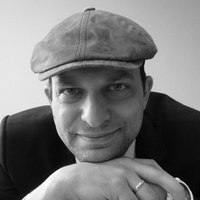- Johannes Gutenberg University
ISTziB Chair of Turcology
Hegelstrasse 59
55122 Mainz
Germany - +49-6131-3938374
- Johannes Gutenberg-Universität Mainz, Orientalistik, Department Memberadd
Page 1. TURCOLOGICA 65 Julian Rentzsch Aspekt im Neuuigurischen Harrassowitz Verlag Page 2. Page 3. Page 4. TURCOLOGICA Herausgegeben von Lars Johanson Band 65 2005 Harrassowitz Verlag . Wiesbaden Page 5. ...
Research Interests:
Research Interests: History and De Gruyter
Research Interests:
Research Interests:
Research Interests:
Research Interests:
Research Interests:
Research Interests:
Research Interests:
Research Interests:
Research Interests:
Research Interests:
Research Interests:
Research Interests:
Research Interests:
Research Interests:
Research Interests: History and De Gruyter
Research Interests:
Research Interests:
Research Interests:
This paper investigates the mechanisms underlying the grammaticalization of Turkic modal auxiliary verbs. Special attention is paid to the linking device between main verb and auxiliary, i.e. the segment that corresponds to the infinitive... more
This paper investigates the mechanisms underlying the grammaticalization of Turkic modal auxiliary verbs. Special attention is paid to the linking device between main verb and auxiliary, i.e. the segment that corresponds to the infinitive in many Standard Average European modal constructions. Turkic modal constructions display a considerable variation regarding this linking device, which, however, can be reduced to a set of seven structural types, the origin and development of which will be investigated. It will be argued that interacting analogous mechanisms that build on formal and semantic principles contribute to the evolution and distribution of these types
Research Interests: History, Grammaticalization, Linguistics, Multidisciplinary, Modal Verb, and 3 moreVerb, Infinitive, and Modal
This contribution deals with four types of vowel developments found in Turkic languages. Two of these, i-umlaut and u-umlaut, areregressive vowel assimilations, the other two – vowel raising and vowel lowering – originate in a reduction... more
This contribution deals with four types of vowel developments found in Turkic languages. Two of these, i-umlaut and u-umlaut, areregressive vowel assimilations, the other two – vowel raising and vowel lowering – originate in a reduction in terms of quantity. In order to get a rough idea of the distribution of the phenomena under discussion, modern Standard Uyghur, a language in which these developments are especially common, is taken as a starting point. Lexemes in which one or more of these changes occur are compared with the cognates in other modern and historical Turkic languages. It turns out that while most of the vowel developments considered here have gained a certain dissemination accross the Turkic world in individual lexical items, the instability in the vowel system is especially striking in the Uyghur area.
Research Interests:
Research Interests:
The present paper aims to register the principal morphological and morphosyntactic items of the Manchu language that encode modal notions and to propose a functional and semantic classification for them. The inventory of items is... more
The present paper aims to register the principal morphological and morphosyntactic items of the Manchu language that encode modal notions and to propose a functional and semantic classification for them. The inventory of items is classified according to three functional categories which are determined by their relationship to aspect within a hierarchy of scope. The position of a given modal item in the scope hierarchy is established by testing whether it is combinable with aspect, and if so, whether the modal item operates on aspect or forms part of the operandum of aspect. The three functional modal categories, which are also mutually distinct in terms of basic semantic properties, are investigated with regard to their internal semantic design. It will be suggested that while the domain of event modality can be adequately described with received theories of modality, the other semantic classes call for alternative approaches.
Research Interests:
Page 1. TURCOLOGICA 65 Julian Rentzsch Aspekt im Neuuigurischen Harrassowitz Verlag Page 2. Page 3. Page 4. TURCOLOGICA Herausgegeben von Lars Johanson Band 65 2005 Harrassowitz Verlag . Wiesbaden Page 5. ...
Research Interests:
Research Interests:
Türkçe adeylem ve ortaç dizgeleri Türk dilini öğrenen yabancılar için sorunlar yaratmaktadır. Bu sorunların bazıları, Türkçe ve Hint-Avrupa dilleri arasındaki yapı farklılığından kaynaklanmaktadır. Bunun dışında, Türkçe adeylem ve ortaç... more
Türkçe adeylem ve ortaç dizgeleri Türk dilini öğrenen yabancılar için sorunlar yaratmaktadır. Bu sorunların bazıları, Türkçe ve Hint-Avrupa dilleri arasındaki yapı farklılığından kaynaklanmaktadır. Bunun dışında, Türkçe adeylem ve ortaç dizgelerinin kendileri de oldukça kapsamlıdır ve çeşitli anlambilimsel ve sözdizimsel karşıtlıklar kodlamaktadır. Adeylem ve ortaç dizgelerine ait birimlerin kümeleri, biçimbilimsel açıdan kesişmekte ve her iki kümede yer alan birimlerin somut bağlamda hangi işlevi yerine getirdiğini çözümlemek, bazen, karmaşık bir deşifre işlemi gerektirmektedir. Üstelik bazı biçimbirimlerin işlev(ler)i, dilbilgisi ve ders kitaplarında günümüze dek tatmin edici bir şekilde betimlenmemiştir. Bu sorunsallık adeylemlerin ve ortaçların yer aldığı yapıları öğrenmeyi zorlaştırmaktadır. Bu çalışmada adeylem ve ortaç dizgeleriyle ilgili sorunlar örneklerle gösterilecek, dizgeler arası işlevsel farklar açıklanacak, dizgeler içi anlambilimsel ve sözdizimsel karşıtlıklar tespit edilecek ve bu değişkenlerin dil öğrenimi açısından önemi saptanacaktır.
